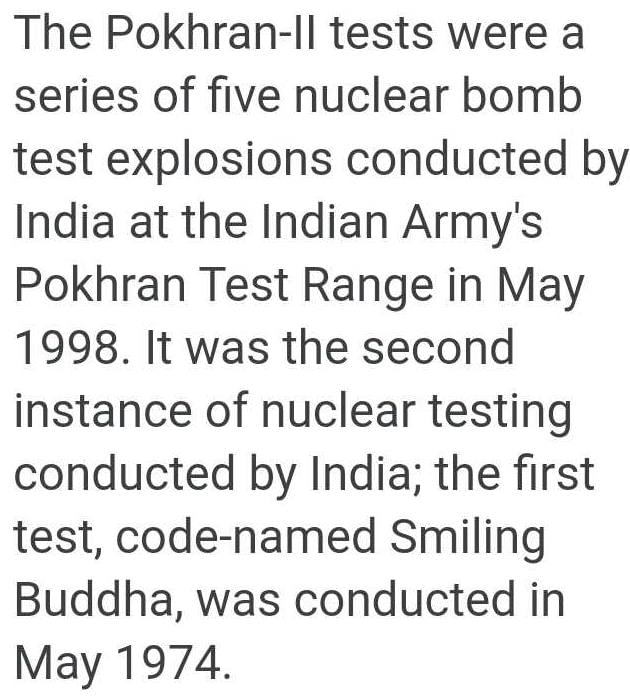Humanities/Arts Exam > Humanities/Arts Questions > India conducted second nuclear test in:a)1972...
Start Learning for Free
India conducted second nuclear test in:
- a)1972
- b)1985
- c)1986
- d)1998
Correct answer is option 'D'. Can you explain this answer?
Verified Answer
India conducted second nuclear test in:a)1972b)1985c)1986d)1998Correct...
India did so as it was surrounded by nuclear-armed countries and it wanted to safeguard itself from them.
Most Upvoted Answer
India conducted second nuclear test in:a)1972b)1985c)1986d)1998Correct...

Free Test
FREE
| Start Free Test |
Community Answer
India conducted second nuclear test in:a)1972b)1985c)1986d)1998Correct...
India's Second Nuclear Test
India conducted its second nuclear test on May 11, 1998, as part of a series of tests known as "Operation Shakti." This marked a significant moment in India's defense strategy and nuclear capabilities.
Background
- India's first nuclear test was conducted in 1974, named "Smiling Buddha," which demonstrated the country's nuclear capability.
- After years of strategic restraint, geopolitical developments in the region and globally prompted India to revisit its nuclear policy.
Operation Shakti
- The tests in 1998 included a series of five nuclear detonations at the Pokhran Test Range in Rajasthan.
- The first two tests on May 11 were followed by three additional tests on May 13, solidifying India’s status as a nuclear-armed state.
- The tests showcased India's technological advancements and served as a response to regional security threats, particularly from neighboring Pakistan.
Global Reaction
- The tests drew widespread international condemnation, leading to sanctions from various countries, especially the United States.
- However, India justified its actions citing national security concerns and the need for a credible deterrent in an unstable region.
Significance
- The 1998 tests established India as a nuclear power, altering the strategic landscape of South Asia.
- It also initiated a debate on nuclear non-proliferation and disarmament, highlighting the complexities of global security dynamics.
In summary, India's second nuclear test in 1998 was a pivotal event that not only reinforced its defense posture but also had lasting implications for regional and international security.
India conducted its second nuclear test on May 11, 1998, as part of a series of tests known as "Operation Shakti." This marked a significant moment in India's defense strategy and nuclear capabilities.
Background
- India's first nuclear test was conducted in 1974, named "Smiling Buddha," which demonstrated the country's nuclear capability.
- After years of strategic restraint, geopolitical developments in the region and globally prompted India to revisit its nuclear policy.
Operation Shakti
- The tests in 1998 included a series of five nuclear detonations at the Pokhran Test Range in Rajasthan.
- The first two tests on May 11 were followed by three additional tests on May 13, solidifying India’s status as a nuclear-armed state.
- The tests showcased India's technological advancements and served as a response to regional security threats, particularly from neighboring Pakistan.
Global Reaction
- The tests drew widespread international condemnation, leading to sanctions from various countries, especially the United States.
- However, India justified its actions citing national security concerns and the need for a credible deterrent in an unstable region.
Significance
- The 1998 tests established India as a nuclear power, altering the strategic landscape of South Asia.
- It also initiated a debate on nuclear non-proliferation and disarmament, highlighting the complexities of global security dynamics.
In summary, India's second nuclear test in 1998 was a pivotal event that not only reinforced its defense posture but also had lasting implications for regional and international security.

|
Explore Courses for Humanities/Arts exam
|

|
Question Description
India conducted second nuclear test in:a)1972b)1985c)1986d)1998Correct answer is option 'D'. Can you explain this answer? for Humanities/Arts 2025 is part of Humanities/Arts preparation. The Question and answers have been prepared according to the Humanities/Arts exam syllabus. Information about India conducted second nuclear test in:a)1972b)1985c)1986d)1998Correct answer is option 'D'. Can you explain this answer? covers all topics & solutions for Humanities/Arts 2025 Exam. Find important definitions, questions, meanings, examples, exercises and tests below for India conducted second nuclear test in:a)1972b)1985c)1986d)1998Correct answer is option 'D'. Can you explain this answer?.
India conducted second nuclear test in:a)1972b)1985c)1986d)1998Correct answer is option 'D'. Can you explain this answer? for Humanities/Arts 2025 is part of Humanities/Arts preparation. The Question and answers have been prepared according to the Humanities/Arts exam syllabus. Information about India conducted second nuclear test in:a)1972b)1985c)1986d)1998Correct answer is option 'D'. Can you explain this answer? covers all topics & solutions for Humanities/Arts 2025 Exam. Find important definitions, questions, meanings, examples, exercises and tests below for India conducted second nuclear test in:a)1972b)1985c)1986d)1998Correct answer is option 'D'. Can you explain this answer?.
Solutions for India conducted second nuclear test in:a)1972b)1985c)1986d)1998Correct answer is option 'D'. Can you explain this answer? in English & in Hindi are available as part of our courses for Humanities/Arts.
Download more important topics, notes, lectures and mock test series for Humanities/Arts Exam by signing up for free.
Here you can find the meaning of India conducted second nuclear test in:a)1972b)1985c)1986d)1998Correct answer is option 'D'. Can you explain this answer? defined & explained in the simplest way possible. Besides giving the explanation of
India conducted second nuclear test in:a)1972b)1985c)1986d)1998Correct answer is option 'D'. Can you explain this answer?, a detailed solution for India conducted second nuclear test in:a)1972b)1985c)1986d)1998Correct answer is option 'D'. Can you explain this answer? has been provided alongside types of India conducted second nuclear test in:a)1972b)1985c)1986d)1998Correct answer is option 'D'. Can you explain this answer? theory, EduRev gives you an
ample number of questions to practice India conducted second nuclear test in:a)1972b)1985c)1986d)1998Correct answer is option 'D'. Can you explain this answer? tests, examples and also practice Humanities/Arts tests.

|
Explore Courses for Humanities/Arts exam
|

|
Signup for Free!
Signup to see your scores go up within 7 days! Learn & Practice with 1000+ FREE Notes, Videos & Tests.























